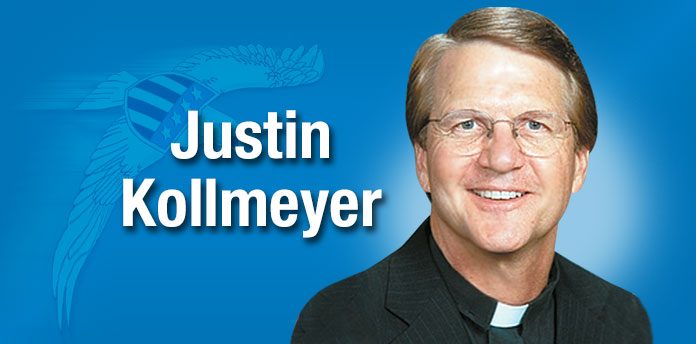My wife and I are just returning from another trip to Ann Arbor, Michigan, where our daughter and her family of husband, three boys, one girl, and one golden retriever live their full and blessed lives. You may remember that we quarantined with them the first four months of the pandemic, which, to say again, was wonderful for us.
This trip on the first weekend of December was a repeat of many other trips we have made this same weekend through the years because of a wonderful Christmas Program that is put on by Concordia University of Ann Arbor. This is the Boar’s Head Festival, which celebrated its forty-third year this year.
I know by searching YouTube that other churches and colleges around the country and in Europe present a similar festival, but I didn’t see any in the South, so chances are you have never experienced one. Let me say here, I hope you get that experience and privilege someday.
To help me describe it to you I will reference “A brief history of the Boar’s Head Festival” written in the printed program by Angela Lai, MA, Sustaining Director, Concordia University Ann Arbor.
She begins by stating that the first Boar’s Head Feast was celebrated in 1340, nearly 800 years ago, at Queen’s College, Oxford, England, where it continues to this day.
The program is an exquisite combination of a Medieval musical play and the telling the story of the birth of Jesus the Savior and all that we know from St. Luke.
The theme song is “The Boar’s Head Carol,” which is the oldest printed Christmas carol in existence, dating back to 1521. Lai writes, “Wild boar had the reputation of being savage animals, roaming freely in the forests of Britain, and were often hunted. The 80th Psalm describes Satan as the ‘wild boar out of the wood,’ so his head is carried in triumph, testimony of his final defeat by the newborn King.”
The English Medieval theme is punctuated by a continual presence of the Beefeaters, who were and are still today the official bodyguards of the king. The authentic Beefeater costumes make for a dramatic connection to their prescribed role both in their historical context and in their parts in the play.
The other characters that make up the Medieval Feast portion of the program include Good King Wenceslas, lords and ladies, dukes and duchesses, wassailers, a court jester, and some children as singers and attendants to the Wise Men. Oh yes, we had two of our grandsons in the production for the first time this year. Proud moments. With a minimal yet convincing stage set, these all make for a quite convincing festive Medieval Feast.
What you need to know and surely must experience for yourself at some time in your life is that it is the music that carries both halves of the festival. And do I mean “carry.” A multi-rank pipe organ, a full orchestra, a choir of strong and pitch-perfect college students, and excellent soloists provide a glorious Christmas experience.
It is said that what’s important about music is that is “moves” us to feel something, not just hear something. Well, believe me, this music “moves” the soul.
Music in the Medieval portion includes “The Boar’s Head Carol,” including the rousing chorus sung by choir and congregation in Latin, “Caput apri defero, Reddens laudes Domino,” translated, “The Boar’s Head I present, rendering praise to The Lord.” Other carols include “Masters in This Hall,” “On This Day Earth Shall Ring,” “Good King Wenceslas,” “Deck The Hall,” “We Wish You A Merry Christmas,” and the “Wassail Carol.”
With the arrival of Mary and Joseph to Bethlehem, the story shifts to the innkeeper, the birth of the newborn King Jesus, the shepherds, and the Wise Men, all in dramatic costumed musical production.
Again, it is the music which takes the congregation to the moving and stirring true meaning of Christmas. The most dramatic of these, in my opinion, is when the shepherds, Wise Men, and then the Medieval king and all the Medieval characters also come to the stable in Bethlehem, and they all bow down to the Savior King Jesus. Most impressive is the highlight moment when the earthly king also bows in full prostration to worship this True King, who has come down from heaven to give life and salvation to all humankind.
The exit from the stage of all the players and characters is accompanied by what I would call, “The most stirring and powerful rendition of ‘O Come, All Ye Faithful’ I have ever experienced.” Full organ, every voice, every instrument, every heart and soul of all actors and entire congregation give full declaration of the birth of Christ The Lord.
Can you hear it?
O come, all ye faithful, joyful and triumphant,
O come ye, O come ye to Bethlehem
Come and behold Him
Born the King of angels:
O come let us adore Him,
O come let us adore Him,
O come let us adore Him,
Christ the Lord!
Yes, I hope you get to experience this or something like it in this Christmas season. Yet, more importantly I pray you will acknowledge the true and real meaning of Christmas, and worship the Christchild on Christmas Eve or Christmas Day in your own church or a church you will find. We have many wonderful churches in our area. Take the whole family, then return for all the blessings the church has to offer all year long.
Merry Christmas, everyone! Christ the Savior is born! Amen!
[Kollmeyer, a thirty-five-year resident of Fayette County, is Pastor Emeritus at Prince of Peace Lutheran Church in Fayetteville. Follow this great church at www.princeofpeacefayette.org. He recently completed an interim pastorate at Word of God Lutheran Church in Sharpsburg. Follow this great church at www.woglutheran.org. You can also find some of Kollmeyer’s recorded sermons over the past year at this website.]






